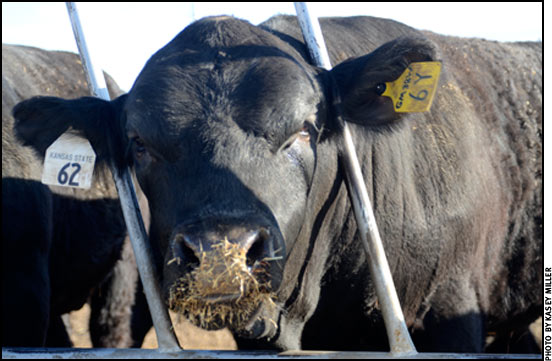 Feeding Flavor
Feeding Flavor
Research shows that beef can be an alternative source of
healthy omega-3 fatty acids.
Flavor is a huge variable that affects consumer acceptability of beef. Grain-fed and grass-fed beef have different flavors, which appeal to different sets of consumers. One of grass-fed beef's favorable attributes championed by proponents is that it contains more of the healthy omega-3 fatty acids, a good-for-you fatty acid more commonly found in fish. Research at Kansas State University (K-State) by Andrea Sexten has found that it is possible to increase omega-3 fatty acids in beef.
"What we're trying to do is show that we can have an alternative protein source that can be omega-3 enriched and not negatively impact flavor. It may be a little different, but it's not a negative impact," says Sexten.

Andrea Sexten, of Kansas State University, explains how fats are digested in the rumen. Typically, cattle are not fed more than 6% fat.
The reason why omega-3 fatty acids are so desirable is that they have the potential to act as an anti-imflammatory agent, boost immune response and reduce the risk of cardiovascular disease. Sexten explained that there are different fats in the diet, and that they get digested in the rumen differently. For instance, forages are rich in glycolipids and omega-3 fatty acids; grains are high in triglycerides; and fat supplements typically have triglycerides and free fatty acids.
Because there are more bacteria in the rumen than there are people on the planet, she said that producers are actually feeding the bacteria in the rumen first. Cattle actually digest byproducts of the bacteria; whereas monogastric animals (pigs and poultry) digest the fed fat itself.
Due to the complexity of the rumen and how it alters fats, Sexten said, "Cattle are not typically fed more than 6% of fat or it will become toxic to the bacterial populations in the rumen and affect the digestibility of other nutrients."
This fact is a large limiter of the omega-3 content in beef, but research has found that feeding flax seed raises the omega-3 content in beef considerably. Flax seed is made up of 42% oil and 23% protein. More than 50% of flax seed's fat profile was omega-3 fatty acids.
The increased omega-3 fatty acids in the diet can also help calf performance because of the anti-imflammatory and immune boost responses, especially helpful for calves going into the feedlot.
"Flax can go to replace the fat in the diet that you might have already, and we're seeing that we can feed it at a higher level. Part of that is because it has the improved protein," she explained.
When looking at the ratio of omega-6 to omega-3 fatty acids between diets (the ideal ratio being 4:1), a steam-flaked corn (SFC) diet showed a 26:1 ratio, a SFC with added tallow showed a 23:1 ratio and SFC with added flax seed showed a 4:1 ratio.
"We included flax seed at about 10%, saw no negative impact on intake, and actually saw improved performance, because intake was not reduced and we had that added energy," she added.











